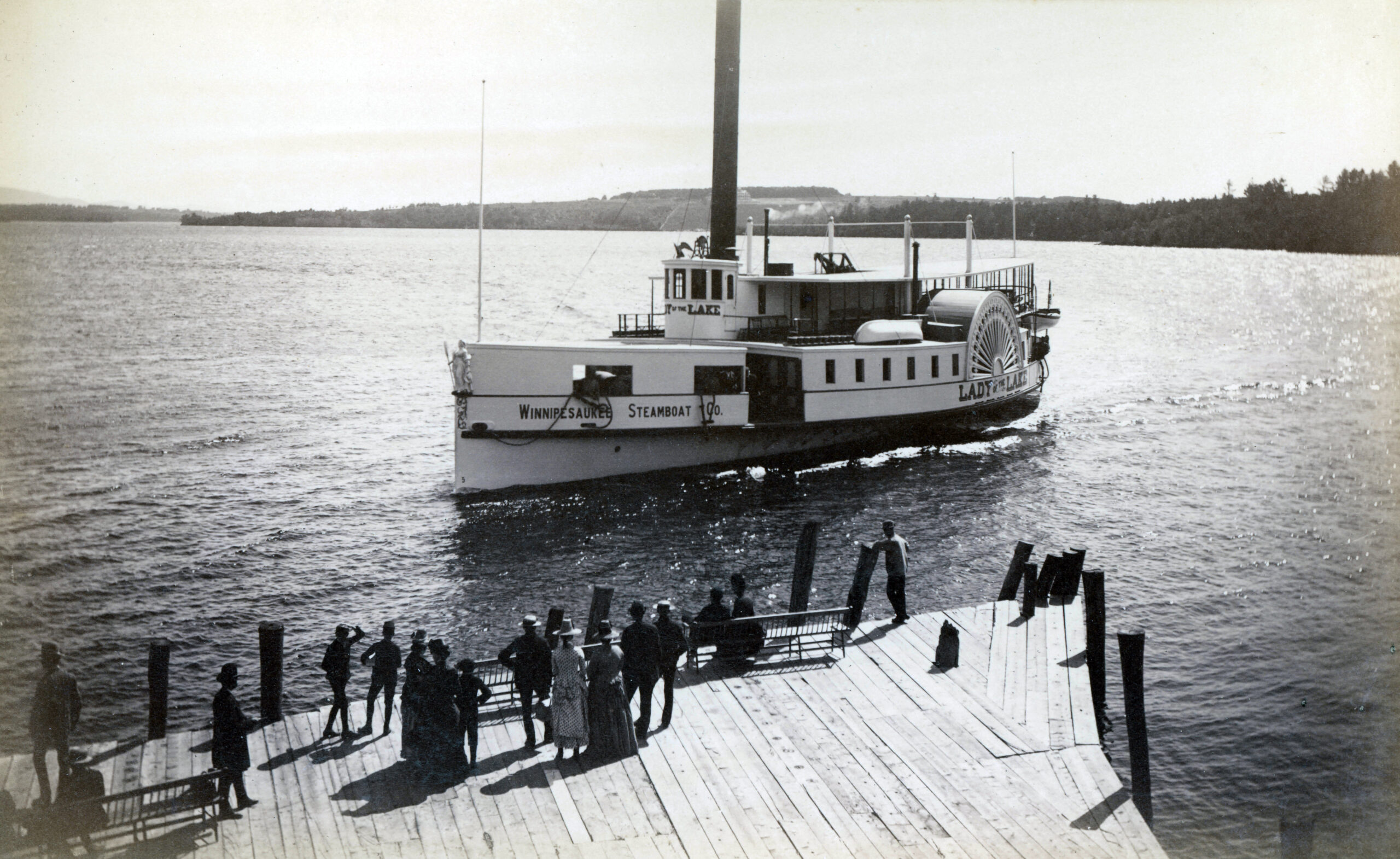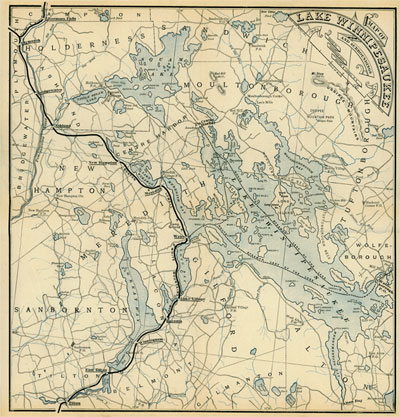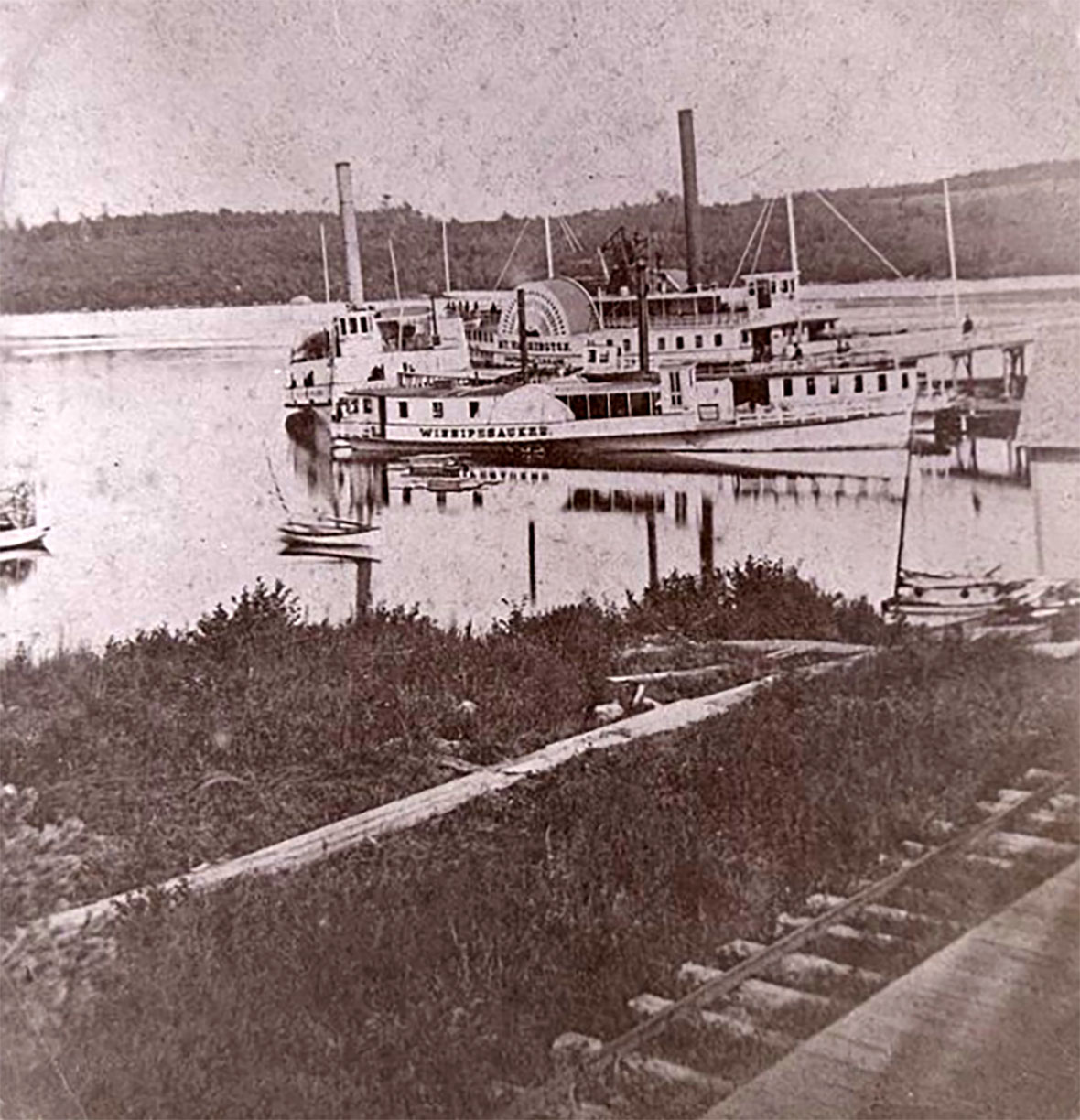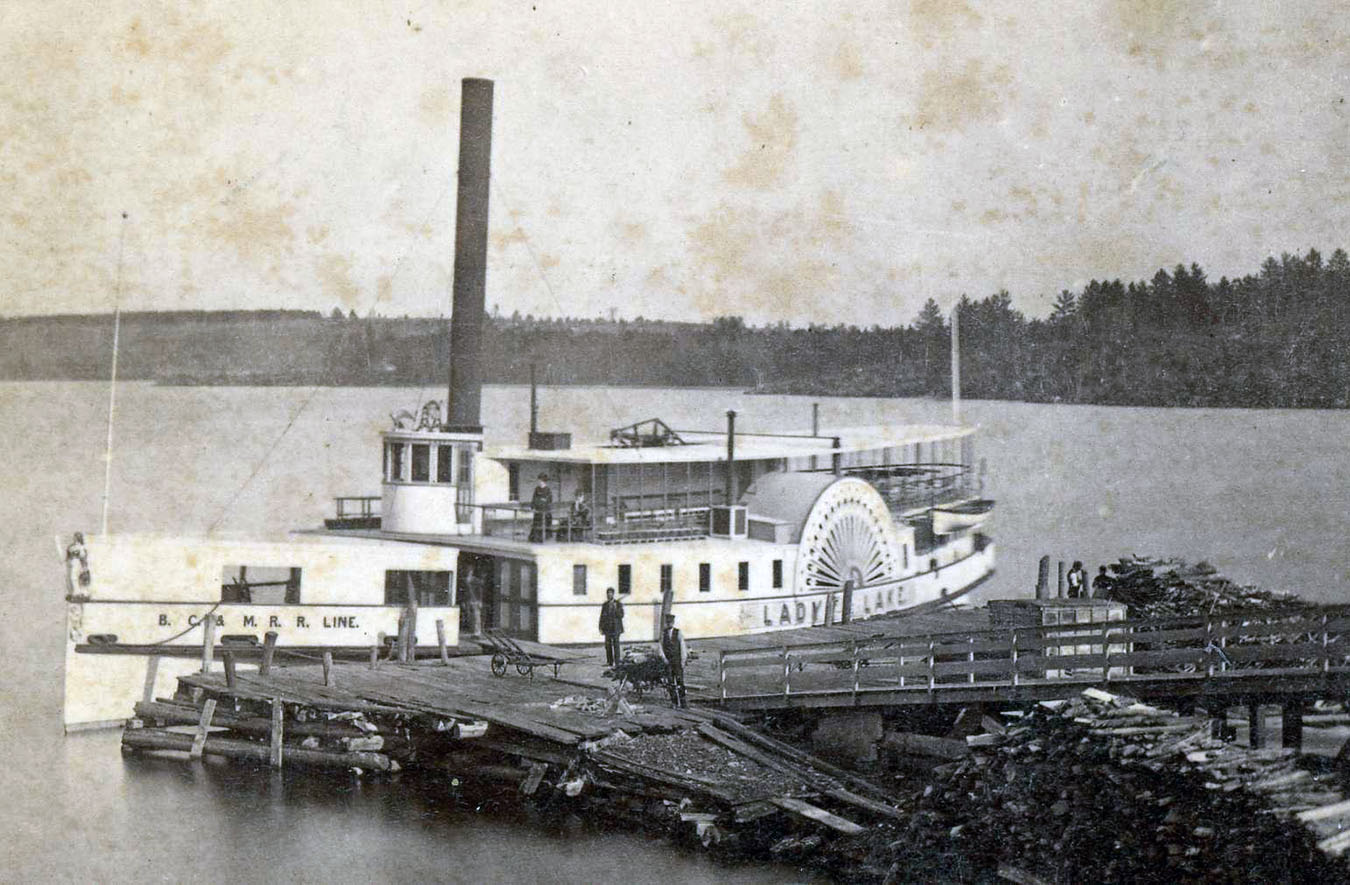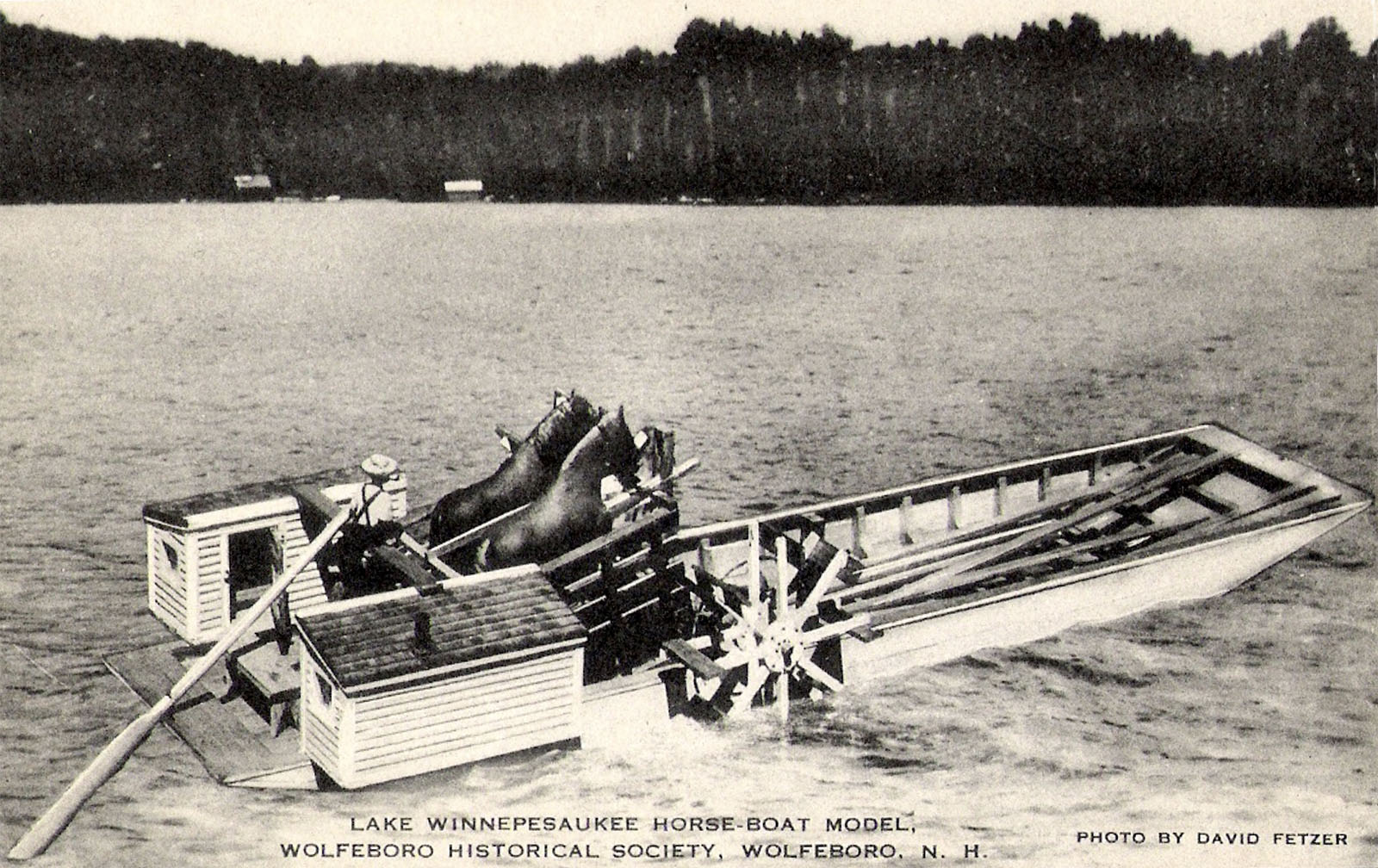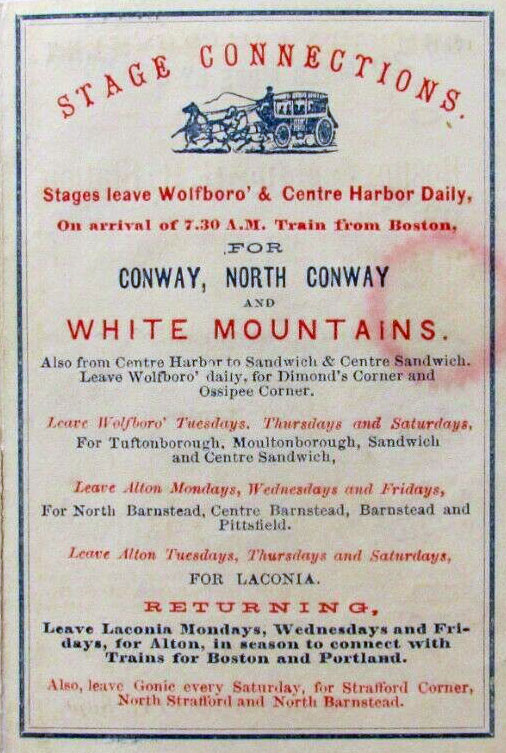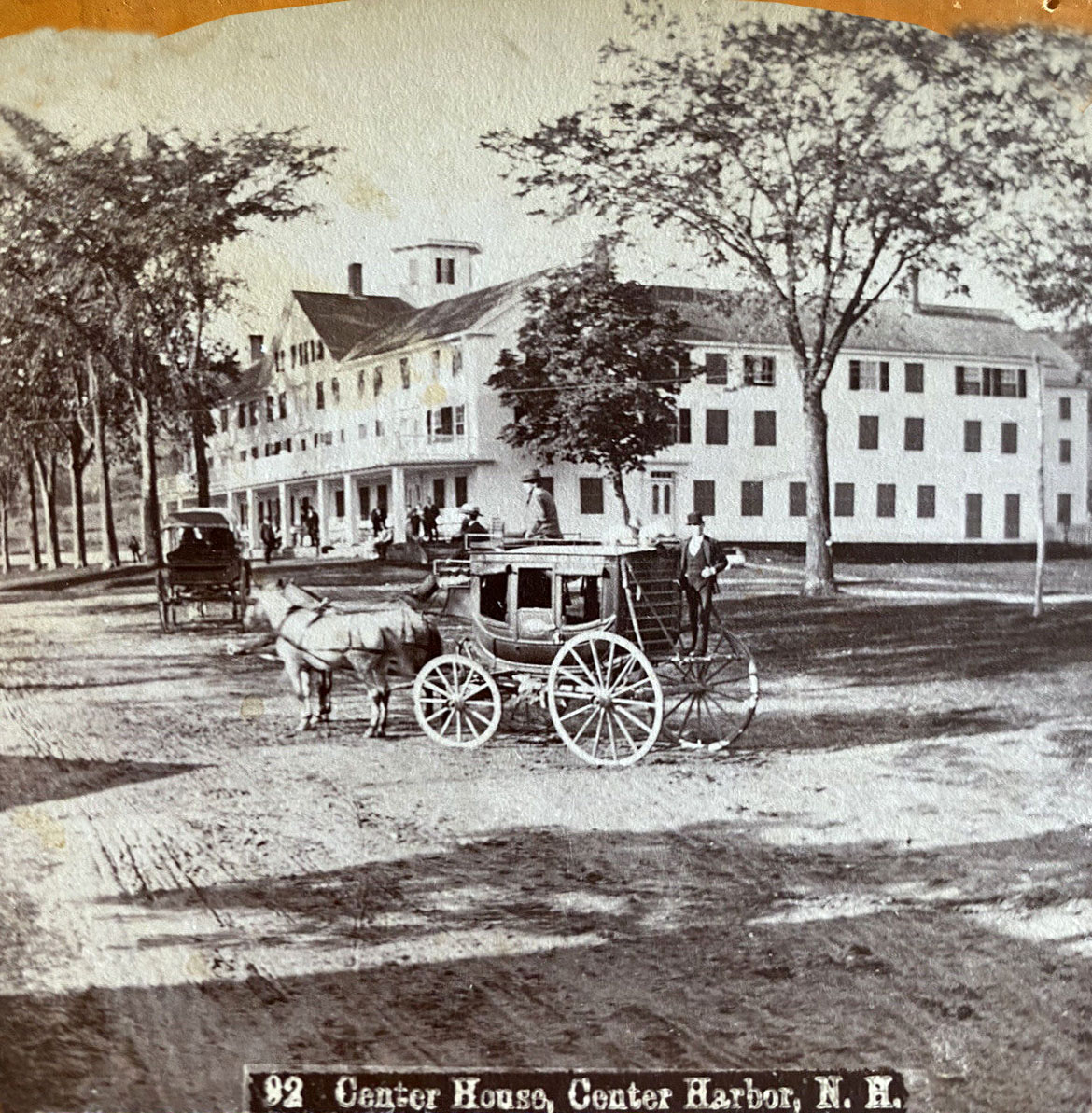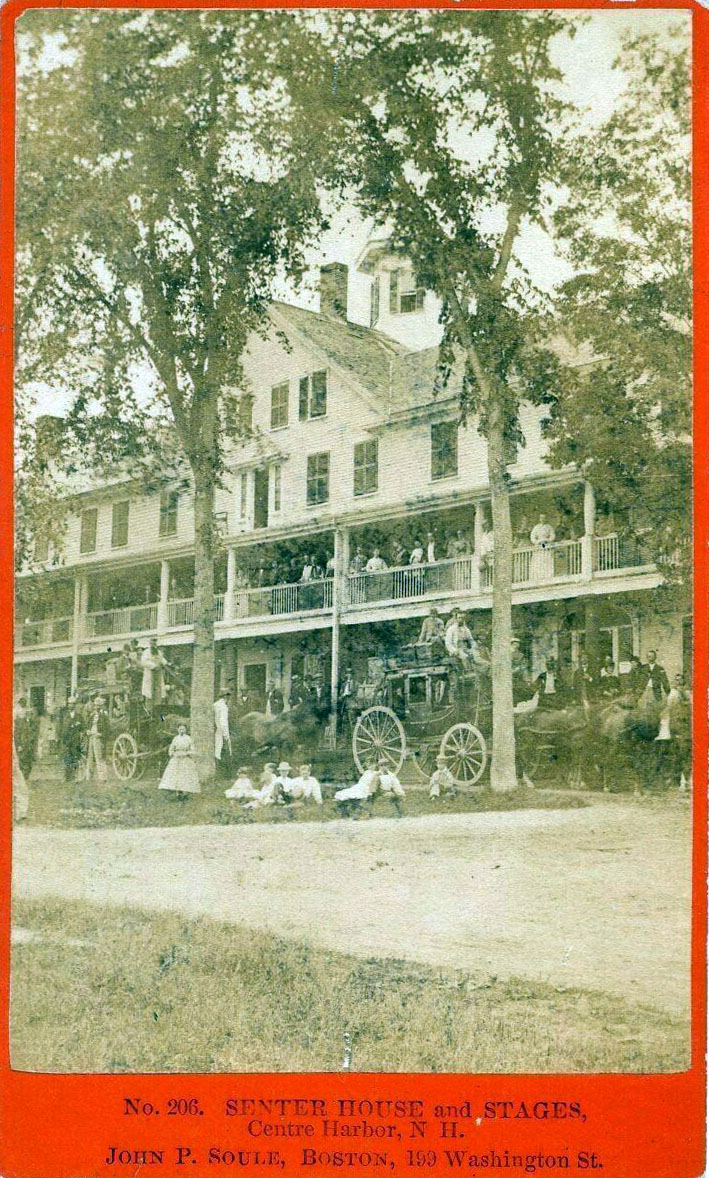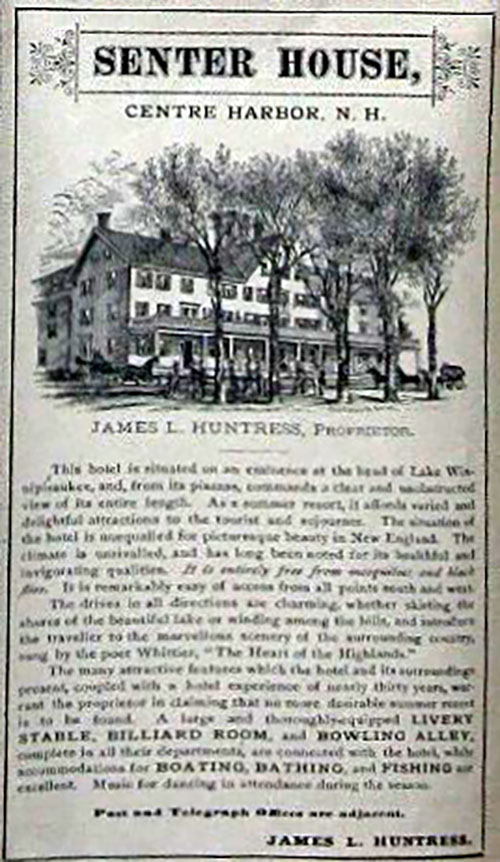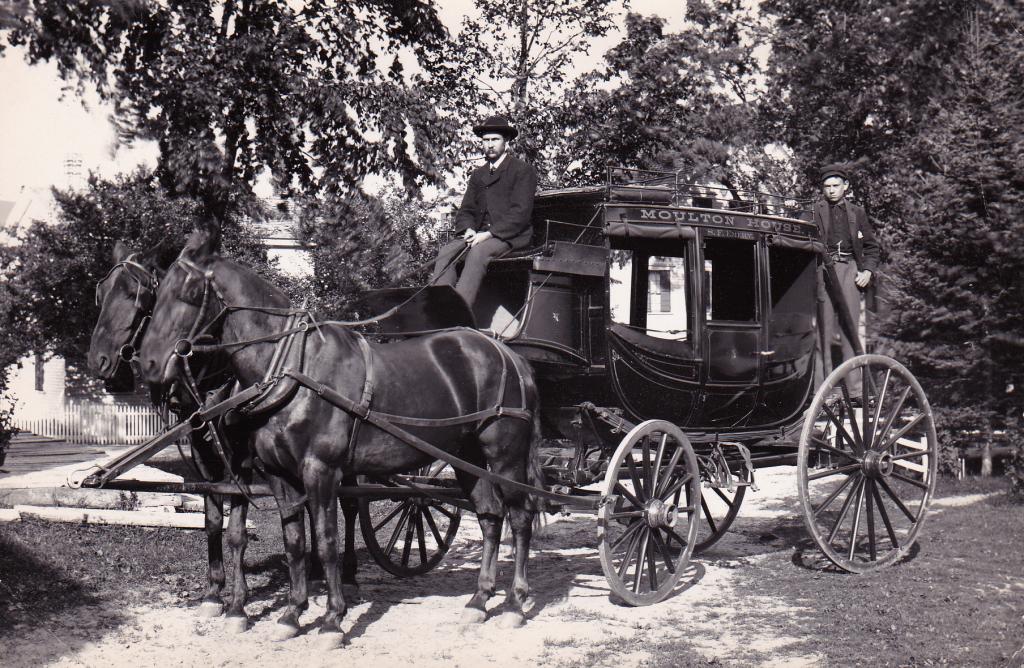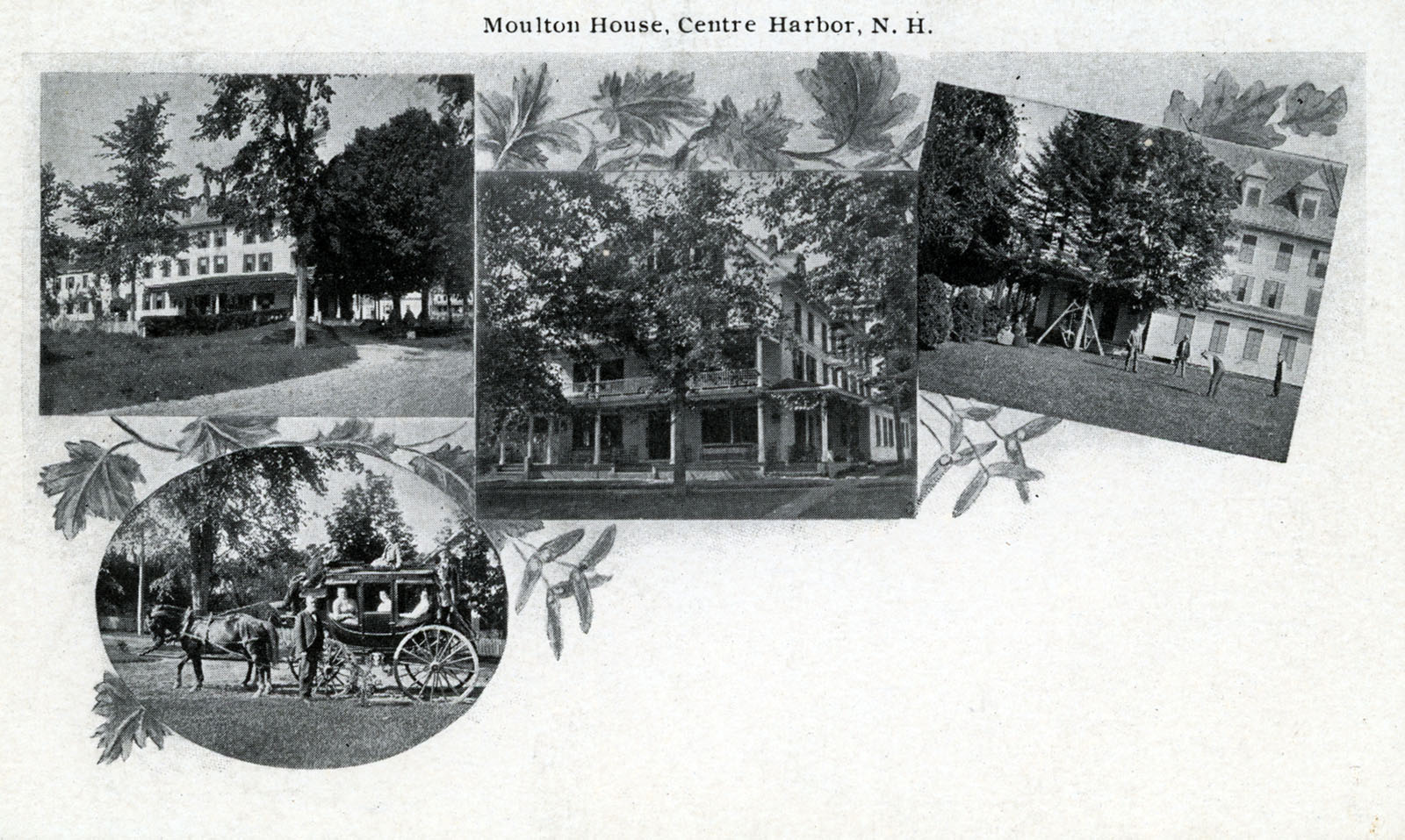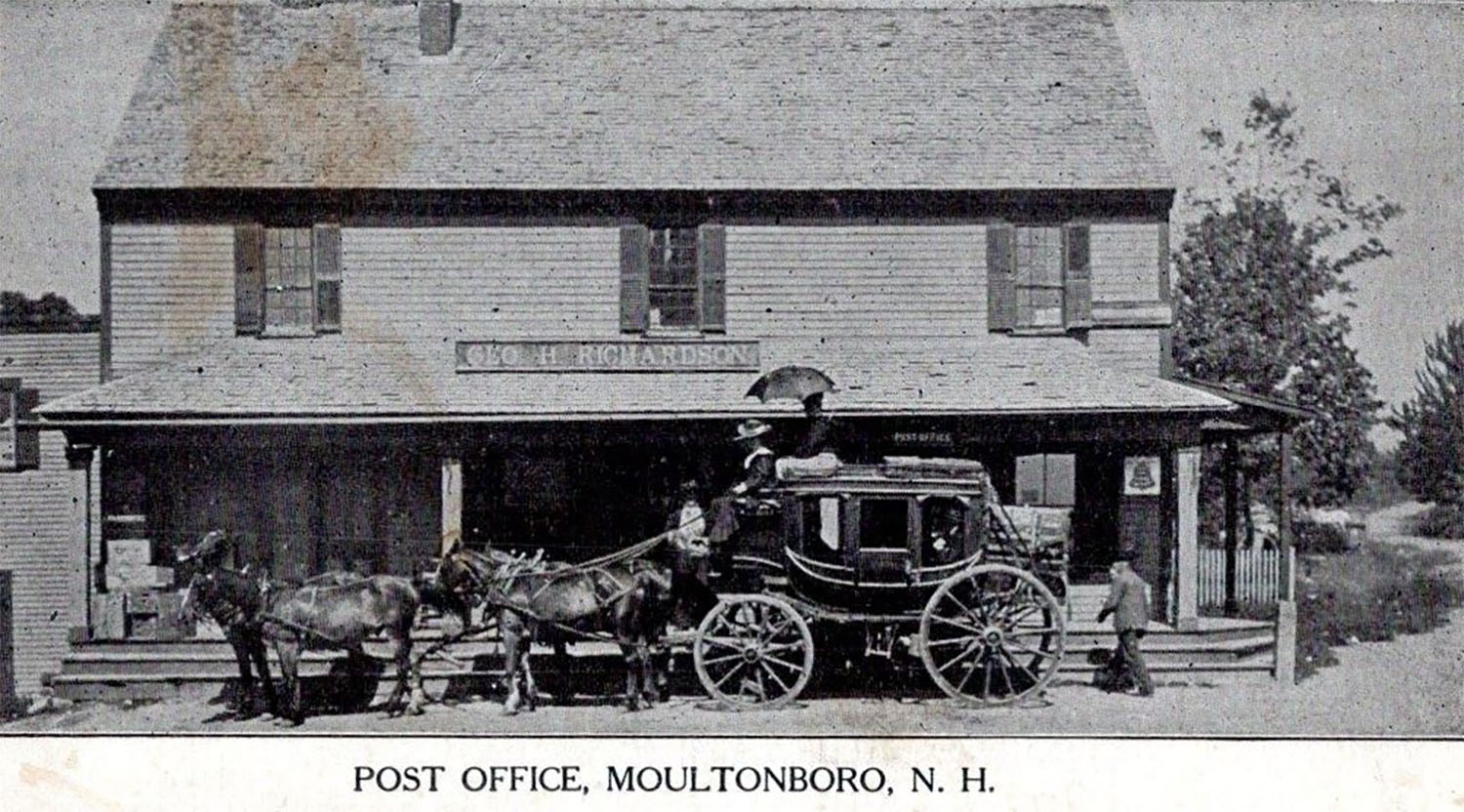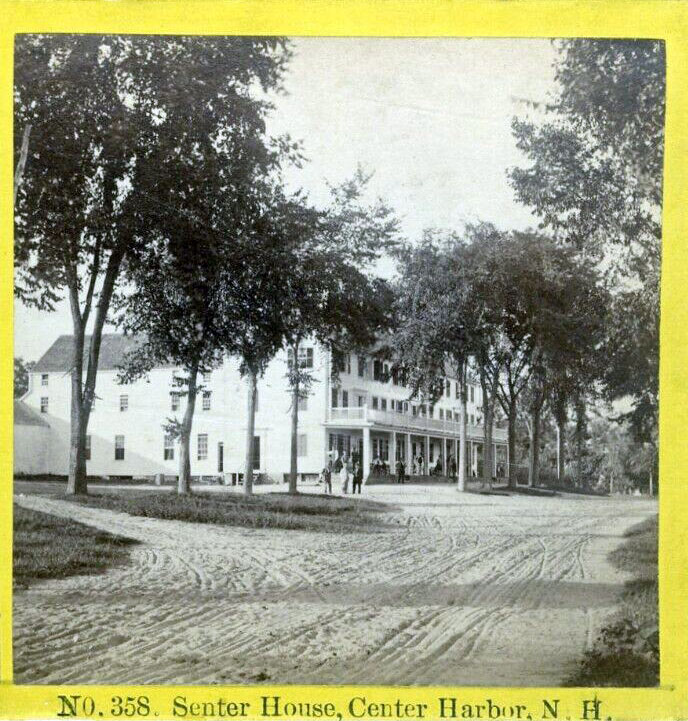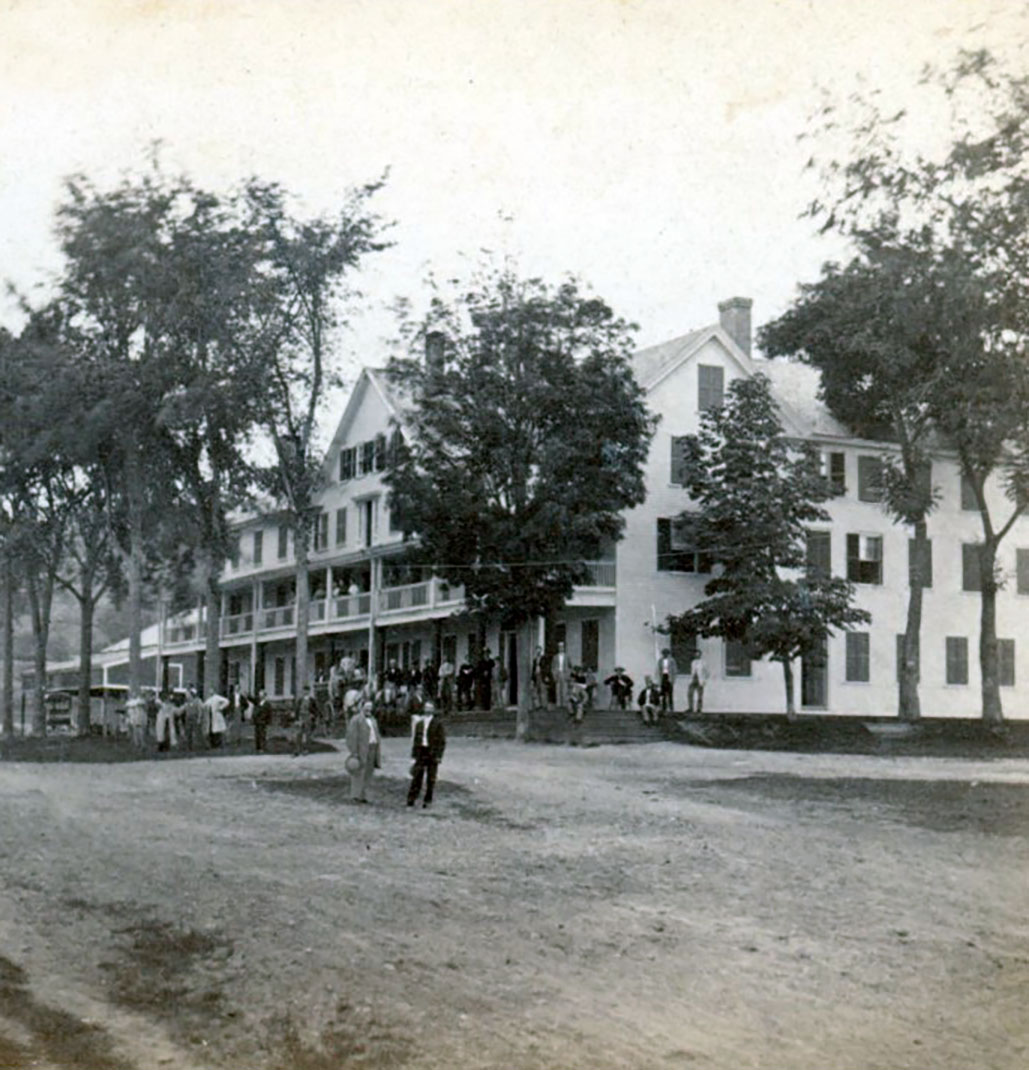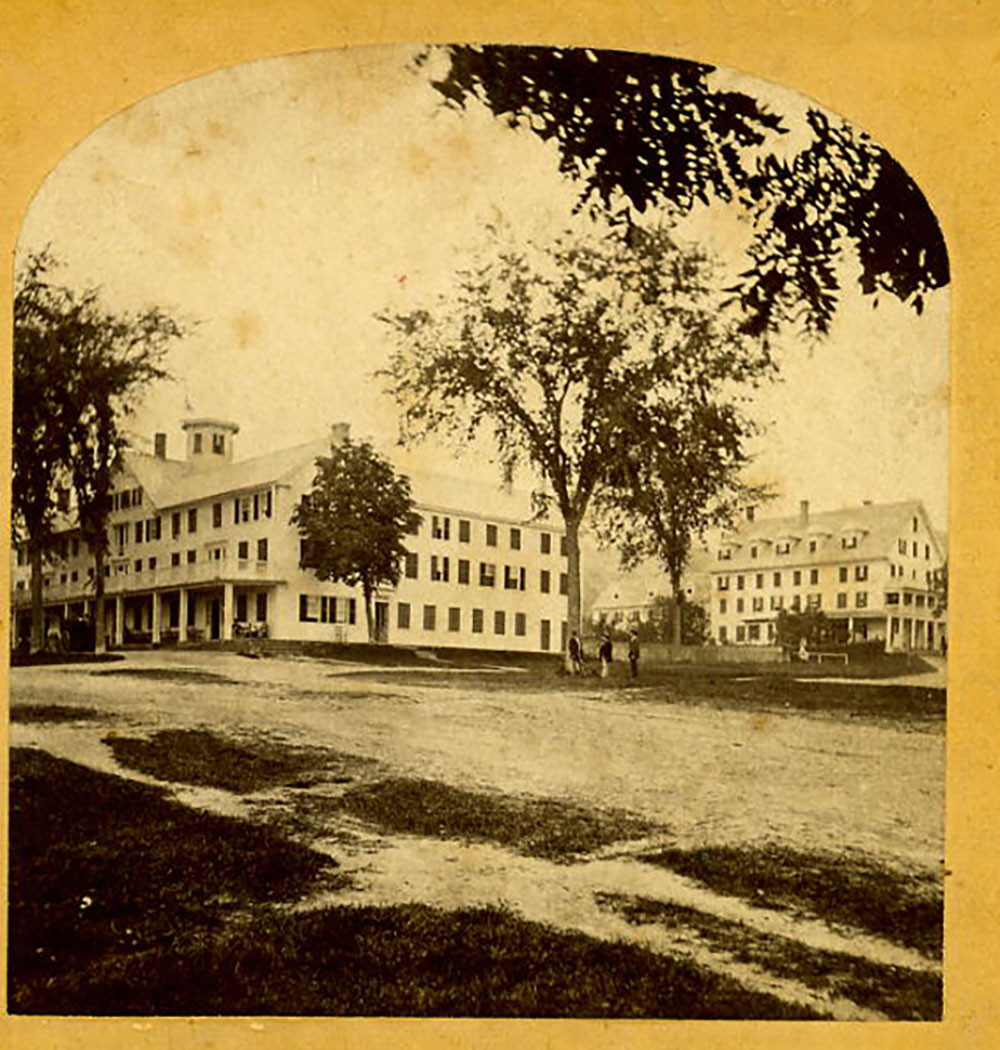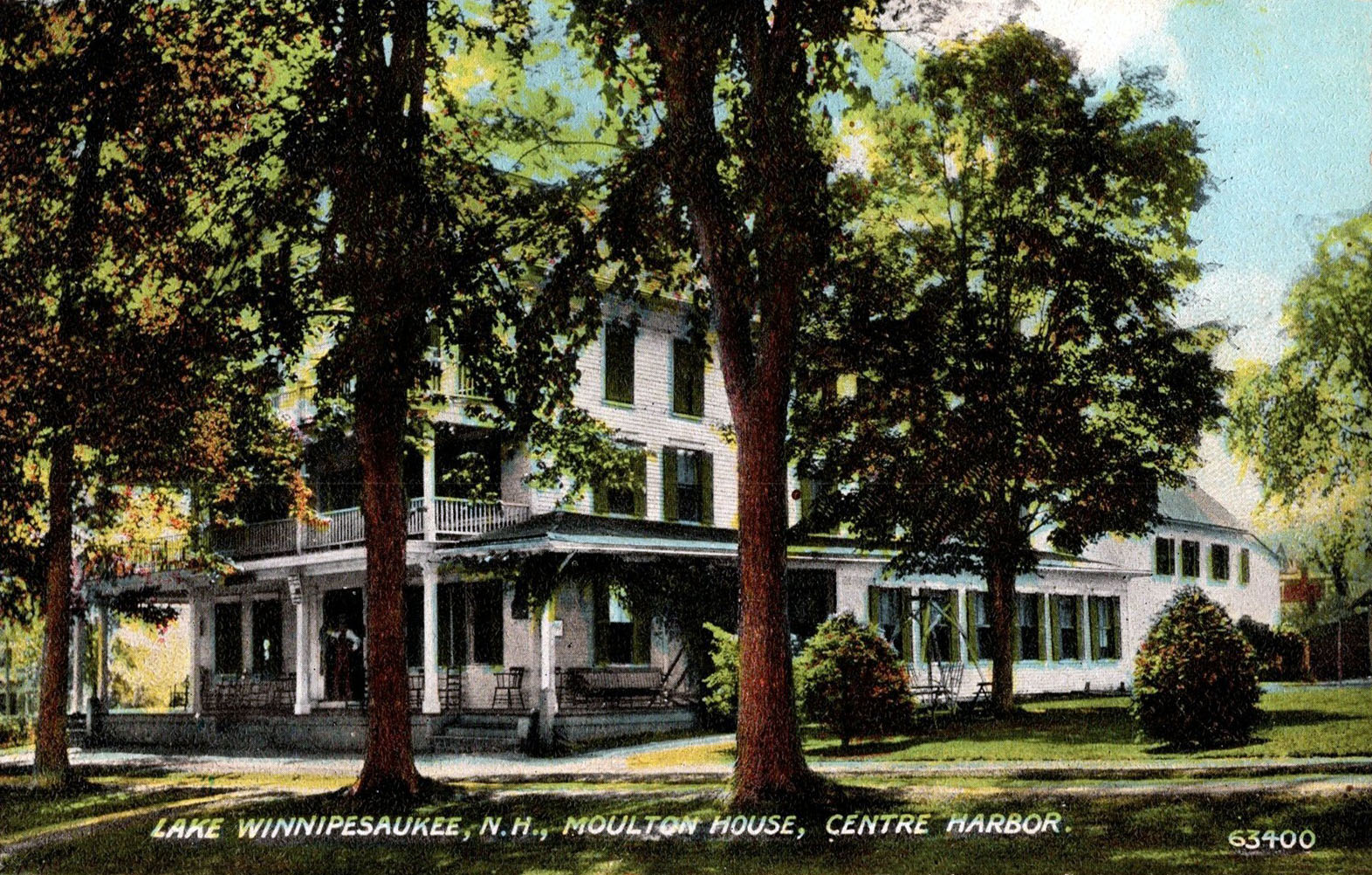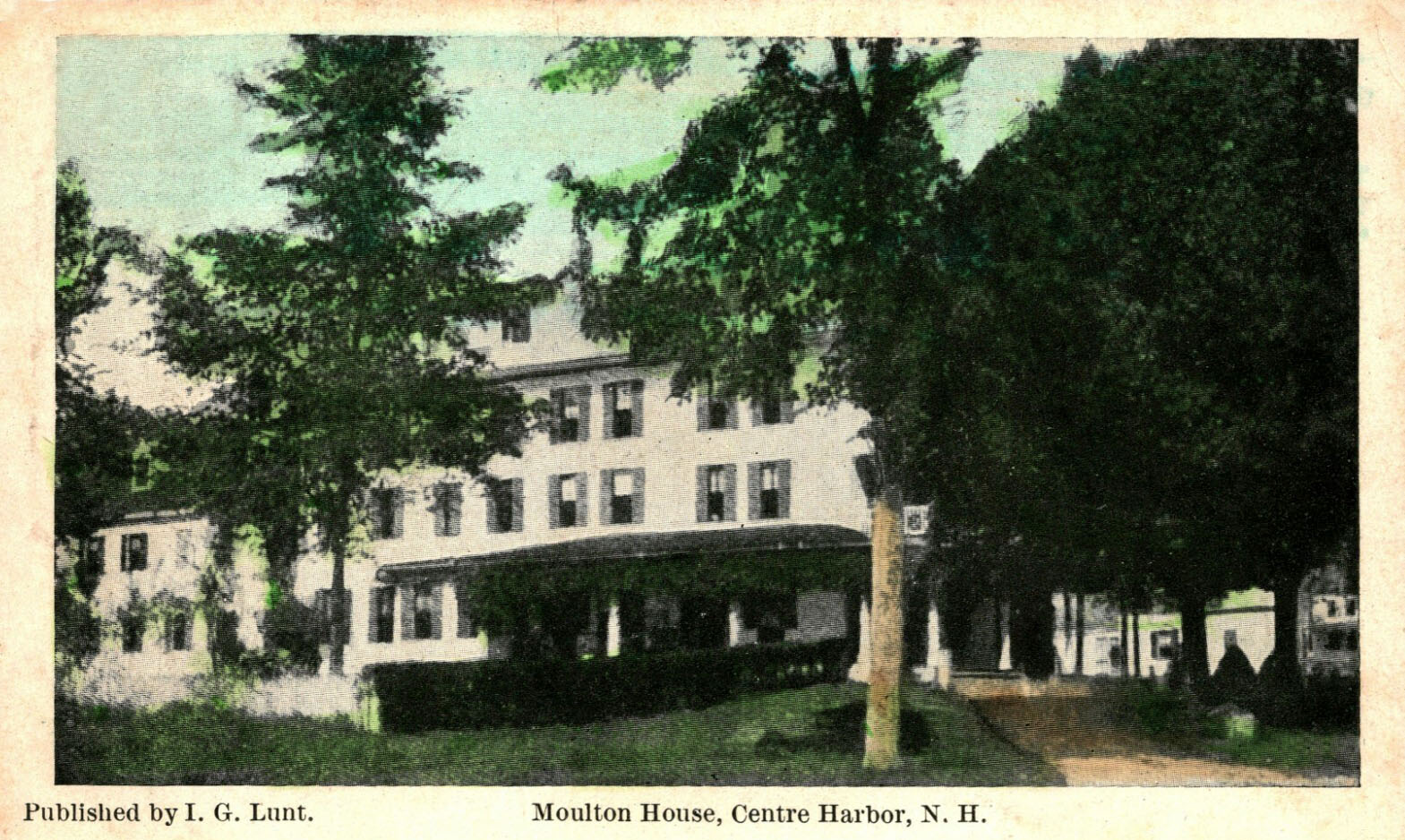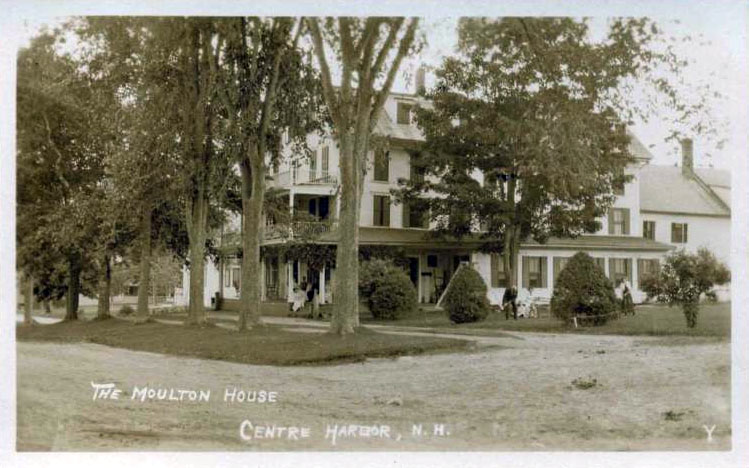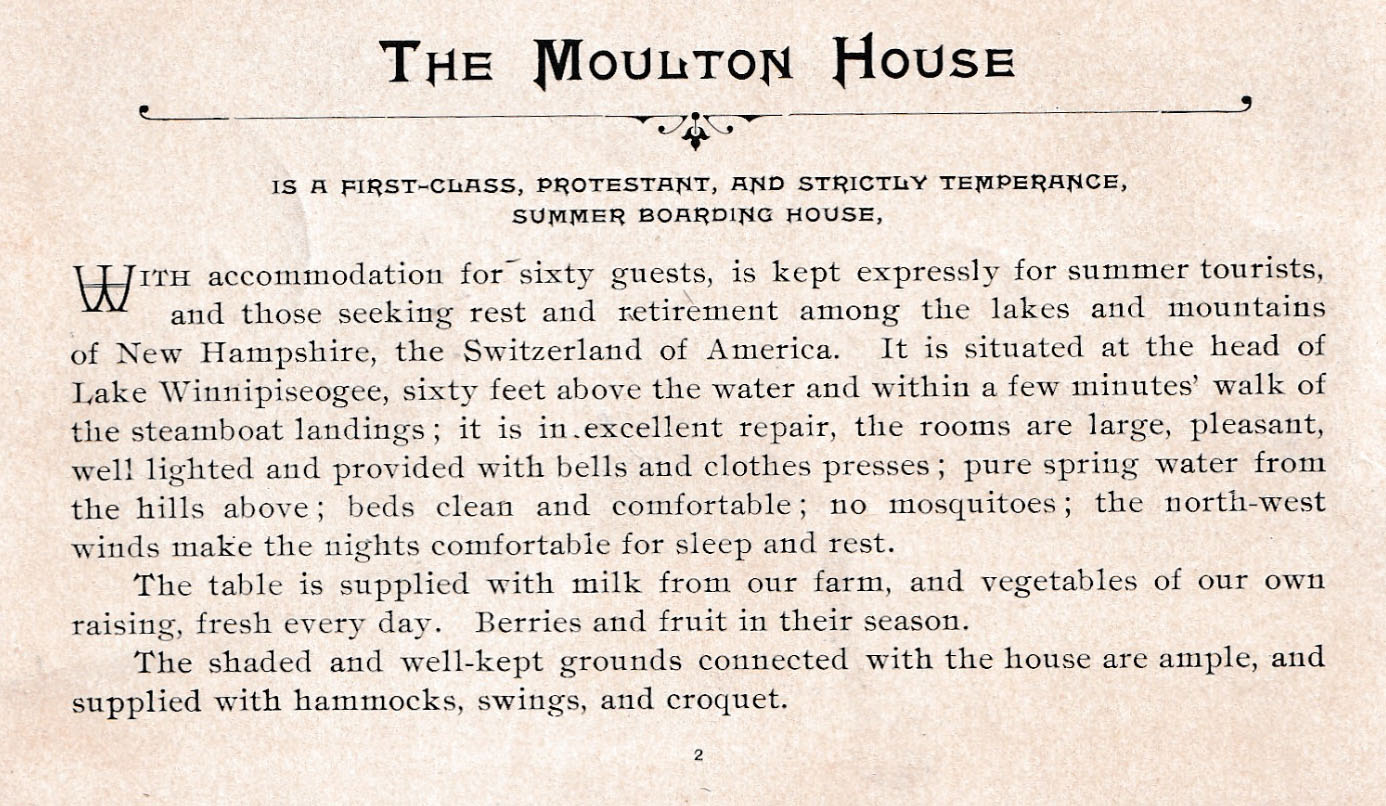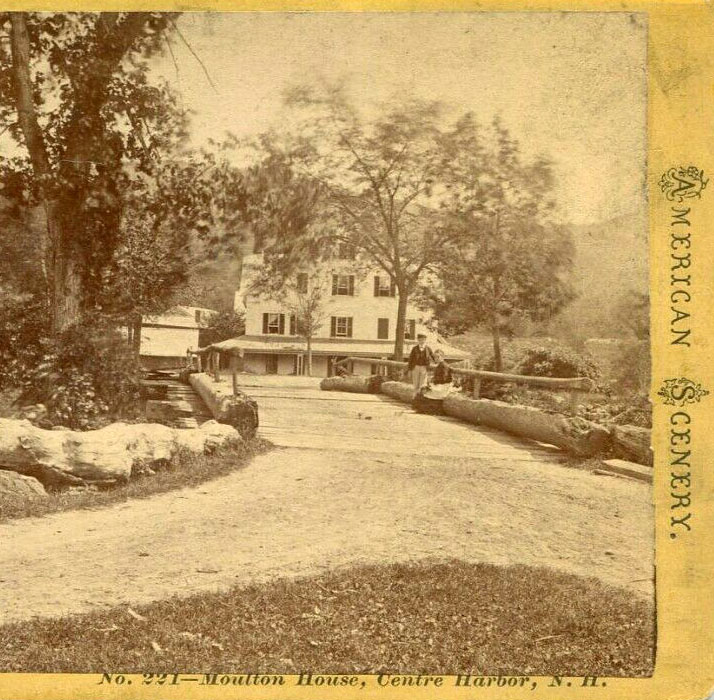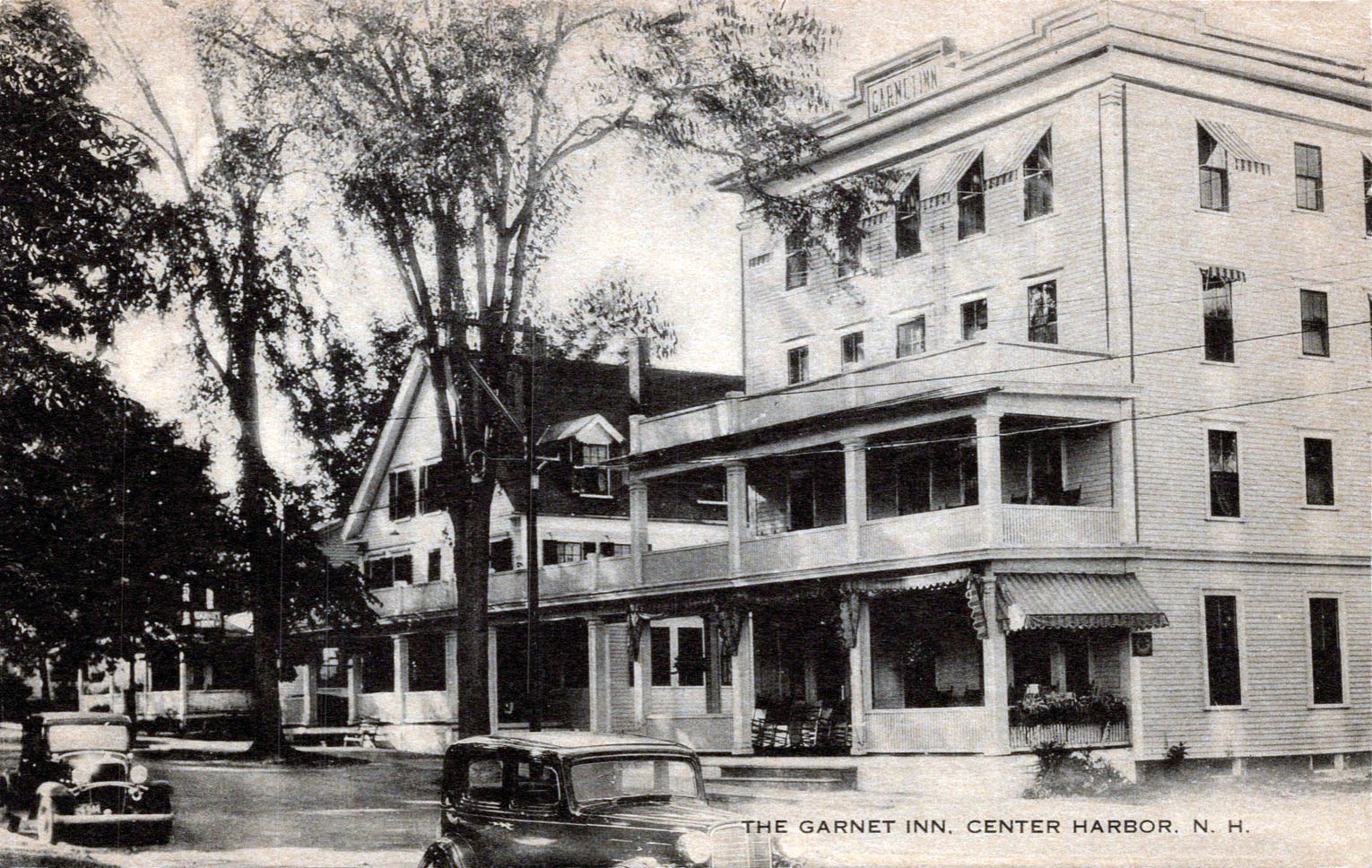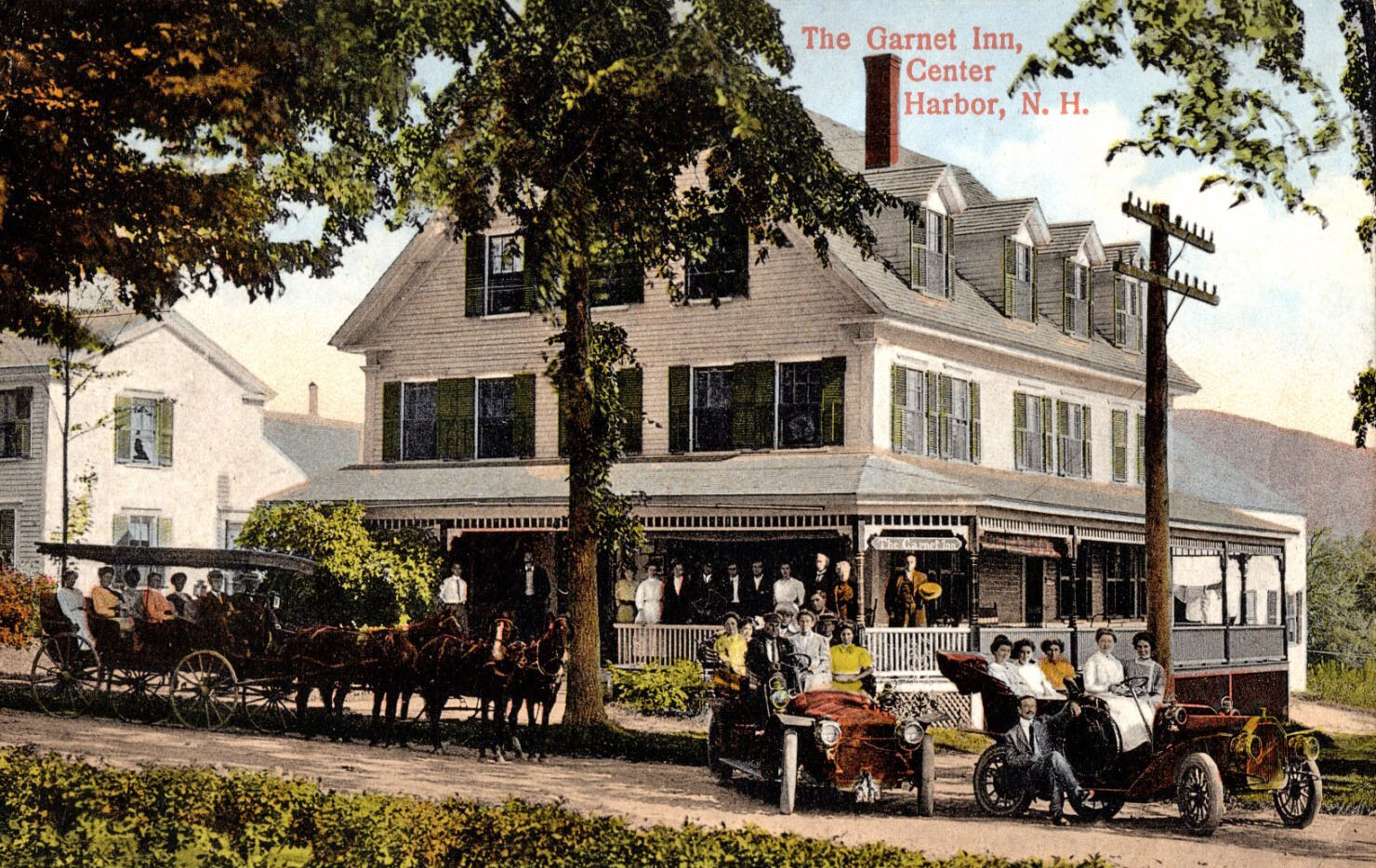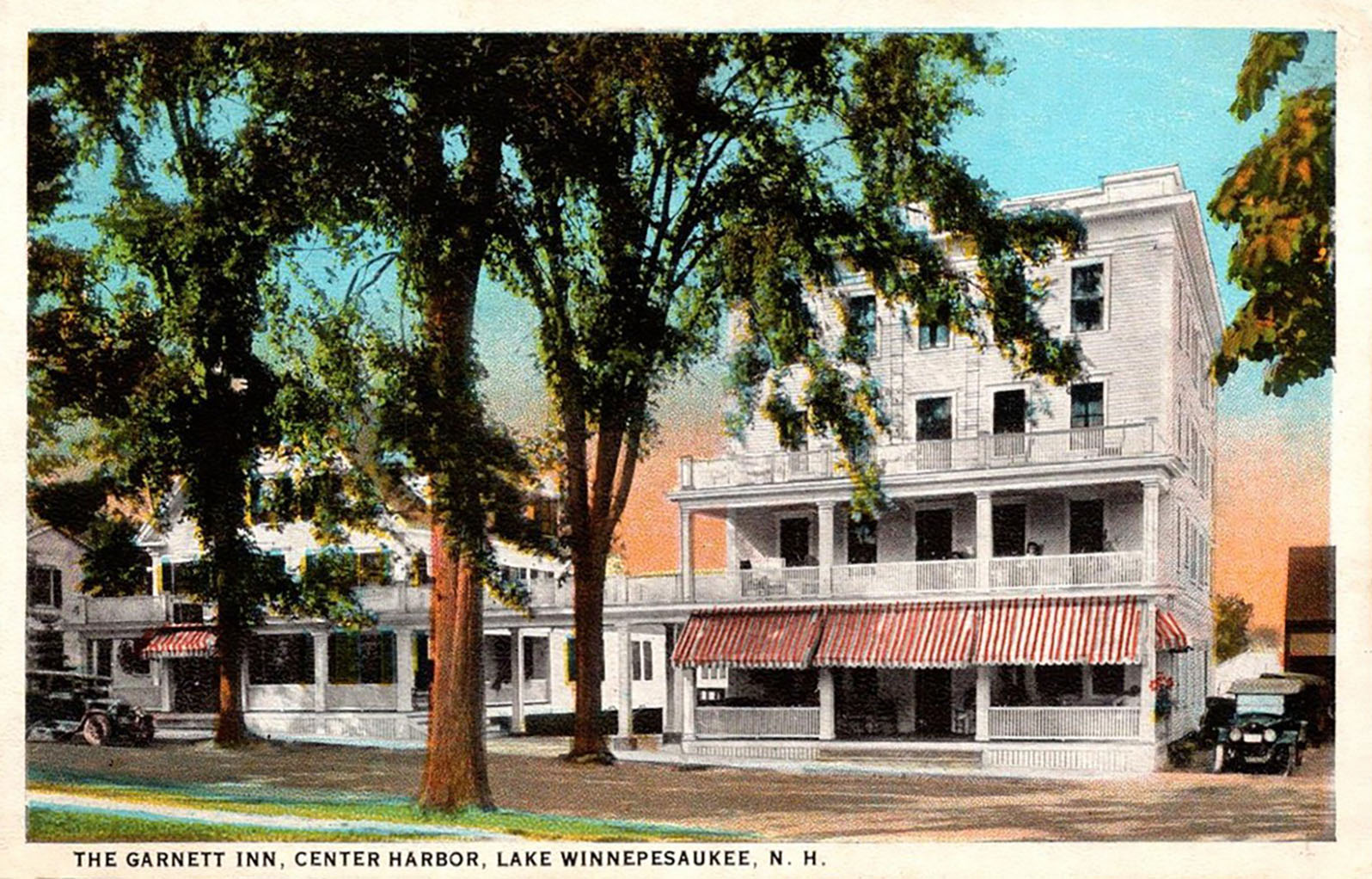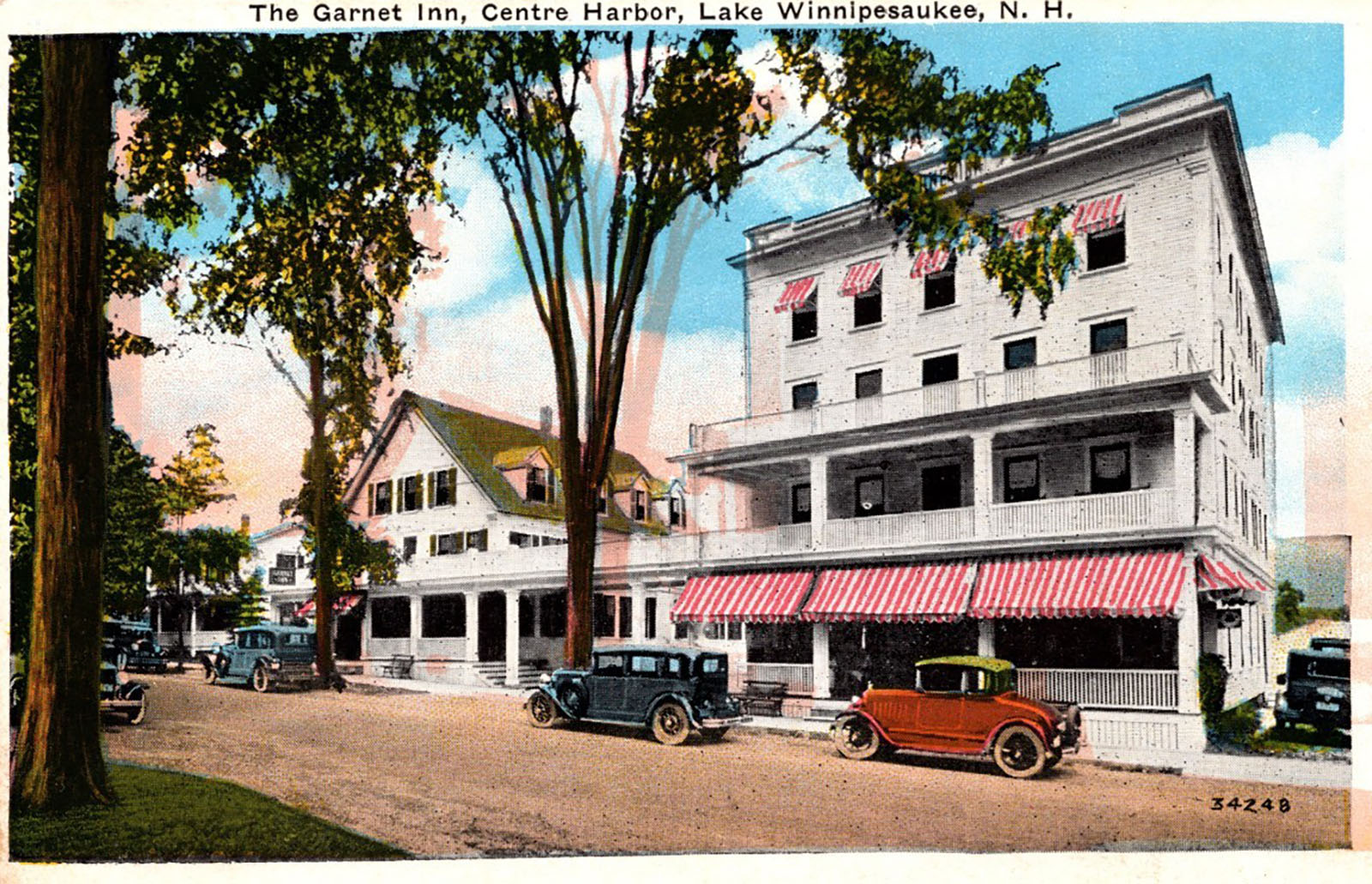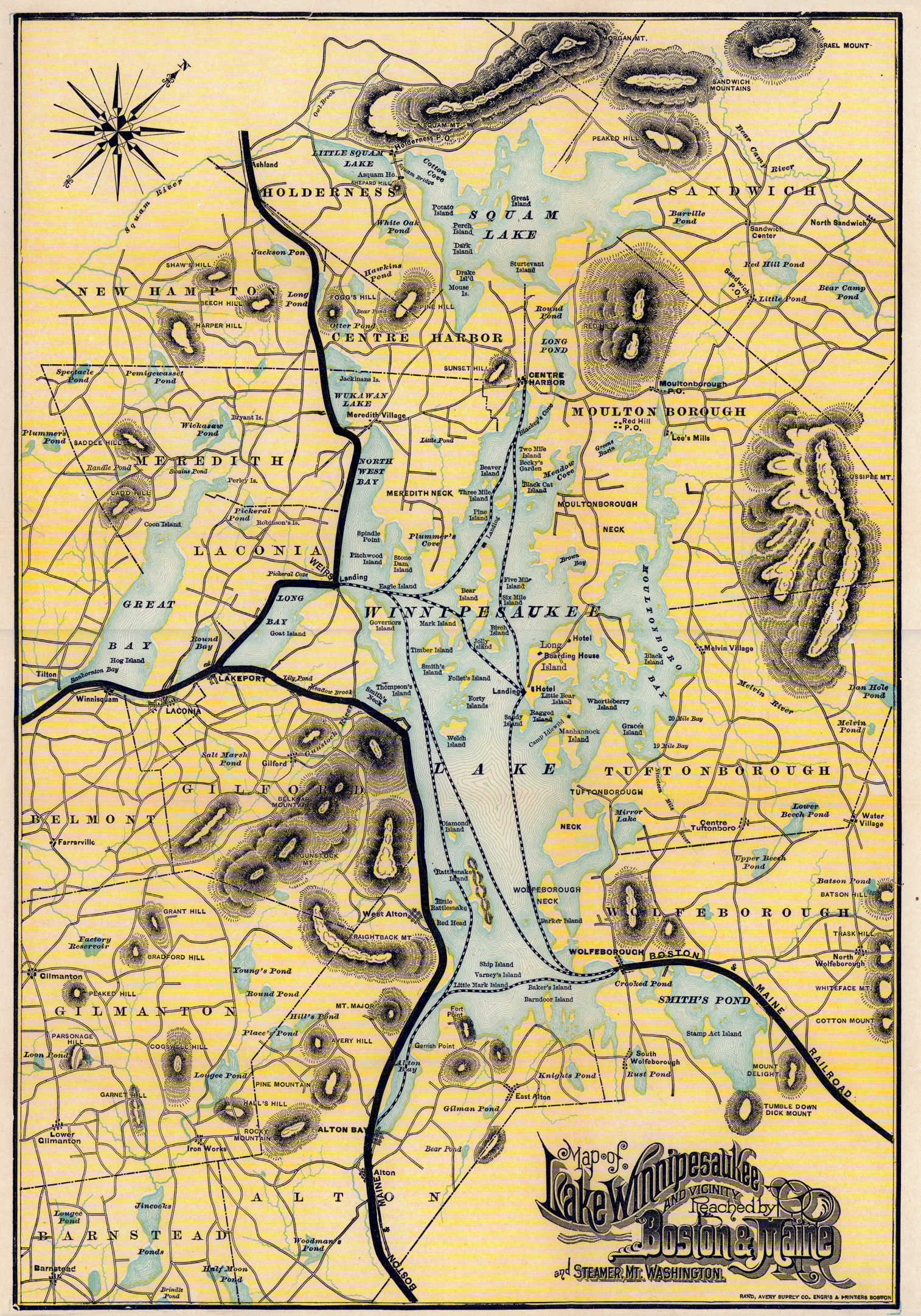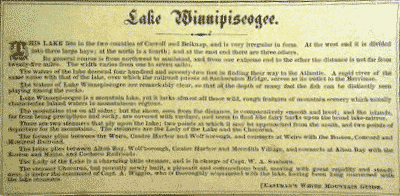Steamships
Which steamships serviced Weirs Beach?
The Lady of the Lake
In 1852, in a shrewd business move to increase rail passenger traffic to Weirs Beach, the Boston, Concord, and Montreal railroad purchased the steamship the Lady of the Lake from the Winnipesaukee Steamship Company. She had been launched without her engines on May 16, 1849 from the shipyard in Lake Village (Lakeport). By the middle of June of 1849, she was completely ready, and made her first voyage to Weirs Beach, where she was an instant success.
The BC&M moved the Lady’s home port from Lakeport to Weirs Beach, where she offered regular, comfortable service to the Lake Winnipesaukee ports of Wolfeboro and Center Harbor (but NOT to Alton Bay!), until her last excursion on September 14, 1893.
On April 30, 1894, the Lady was towed from Weirs Beach to Lakeport for dismantling, but that never occurred. Only her engines were removed. Then, on June 14, 1894, she was towed to Glendale Cove. There, according to a Laconia Democrat article, she was “…to be used for several months by Mr. Andrew Smith, contractor, of Plymouth, with his crew of men, who are to put in a foundation for the new house to be erected this season on Locke’s Hill by B.A. Kimball of the C&M railroad.” After her use as a floating hotel for workers building Kimball Castle, she was purposely sunk. The plan had been to sink her in deep water near Rattlesnake Island, but the old ship never made it out of the Cove. Now, she is Lake Winnipesaukee’s most famous dive wreck, lying only 30 feet deep in front of NH Marine Patrol headquarters. Later, Glendale Cove was named after Mr. Smith, the contractor, becoming Smith Cove. The exact year of the sinking of the Lady needs further research, as the Castle took several years, not months, to build, but it probably occured in 1896.
The Lady approaching the wharf at Weirs Beach while passengers await. The figurine of the Lady is clearly seen on the prow of the vessel.
Who was the Lady of the Lake? Not as well known is the origins of her name. She was Ellen Douglas, the immortal Scotch lassie with the paddle in her hand, from Sir Walter Scott’s The Lady of the Lake, first published in 1810. The heroic, full-size figurine of the Lady, which had adorned the prow of the namesake Lake Winnipesaukee steamship for so many years, now resides in the New Hampshire Historical Society Museum in Concord, NH.
The Mount Washington
The original Mount Washington, owned by the competing Boston and Maine railroad, was built and launched from Alton Bay on May 30, 1872, where she began service on July 4. She was longer, faster, and more luxurious than the Lady of the Lake. And for 67 years, she carried thousands of passengers every summer on her decks.
The Mount’s original home port was Alton Bay, where she had replaced the B&M’s original steamer, the Chocorua. From there, the Mount offered service to Wolfeboro, Center Harbor, and occasionally, Meredith – but NOT to Weirs Beach! The B&M’s northern terminus was in Alton Bay. Here are 1870 and 1884 B&M system maps showing the line to Alton Bay. In 1863, the B&M had leased the Dover & Winnipiseogee RR, which had been created on June 1, 1862, from the Cocheco RR, which had reached Alton Bay in September, 1851. In June, 1892, the B&M purchased the line. At that time, the line included the Lake Shore Railroad branch, which ran from Alton Bay to Lakeport from 1890-1935.
For a period of about 40 years, there was an intense rivalry between the competing railroads that serviced Weirs Beach and Alton Bay, and their competing steamships. Neither steamship was allowed to dock in her rival’s home port. However, both steamships docked in the neutral ports of Center Harbor, Long Island, and Wolfboro. Click here for Calvert’s 1885 Lake Winnipesaukee map showing the routes of BOTH steamships. (The map was produced for the original Weirs Times, and is now reproduced in every issue of the contemporary Weirs Times.)
During the first half of this period of competition, the Lady was the better, faster boat than her rival, the Chocorua. But during the second half of the competitive period, the Mount was clearly the superior vessel. It was not until 1894, following the retirement of the Lady of the Lake, that the Mount moved her home port to Weirs Beach, and that one vessel began servicing all FOUR major ports on the Lake – not only Wolfeboro and Center Harbor, but BOTH Alton Bay AND Weirs Beach. (With the move to Weirs Beach, the Mount stopped cruising to Meredith for the next 35 years. It wasn’t until 1930, after Meredith rebuilt its waterfront, that the Mount resumed occasional cruises to Meredith.)
Not only were railroads and steamships in competition, but so was the name of the Lake! The railroads that serviced Weirs Beach had always named the Lake “Winnipesaukee” (often mis-spelled “Winnepesaukee”), but the railroads that serviced Alton Bay had always named the Lake “Winnipiseogee” (often mis-spelled “Winnepiseogee”). It was not until 1933, by an act of the NH legislature, that the spelling of the name of the Lake was formalized – and in this case, the Weirs Beach spelling won out! (The meaning of the name of the Lake is a controversy that has never been resolved.)
The Lady of the Lake and the Mount Washington together at Center Harbor, circa 1885. Click here to see many additional photos.
The Winnipesaukee Steamboat
Below, an extremely rare photo, taken in the late 1870s, shows THREE steamboats docked at Weirs Beach – the Mount Washington, the Lady of the Lake, and the lesser-known Winnipesaukee. The photo can be identified as being taken at Weirs Beach by the ramp descending in the background. No other port on the Lake featured a descending ramp.
All three steamboats were of the sidewheel paddlewheel variety, featuring two matching paddle wheels amidships, one on each side. This was the dominant steamboat form on the lake during the mid-nineteenth century. Two other paddlewheel types, with a single exposed paddlewheel in the rear, or a single paddlewheel hidden amidships onboard, were not used on the lake. Towards the end of the nineteenth century, the sidewheel paddlewheel type of propulsion fell out of favor, being replaced by stern propellers, still driven by steam engines. The Governor Endicott and the Uncle Sam, built during the early twentieth centrury, were of this latter type.
The Winnipesaukee was a “scow” type of steamboat. This refers to a type of steamboat that utilizes a scow hull, which is a flat-bottomed, wide, and shallow-draft vessel. Scow hulls were chosen for their ability to navigate shallow waters and their capacity to carry substantial cargo. Typically, the engine was taken from a sawmill. The boiler was set in brick, and the moving parts of the sidewheel machinery were exposed above decks.
Robert and Lanson Lamprey first built the Winnipesaukee in the traditional form. As boating continued its evolution on the lake, the Winnipesaukee was repaired extensively by being cut in two and having twenty feet added to her hull length. At the same time, the then conventional type of bow was added, and the boat placed back in passenger carrying service.
In 1880 the Winnipesaukee sailed from Alton Bay on an excursion trip, carrying a capacity crowd. The craft had scarcely passed Little Mark Island when a strong northwest wind swept down across the Broads. Her navigators attempted to continue the voyage, but the extensive repairs to her hull had been faulty, and she was weak where the new twenty foot section was joined to the old planking. The boat started to break up under the terrific pounding of the waves, and, in an effort to save the lives of all on board, she was run into Rolins Cove on Smith Point, her final resting place.
In 1939, on December 22, during a fire that also destroyed the Weirs Beach railroad station and wharf, the original Mount Washington, the last remaining sidewheel paddlewheel steamship on the lake, burned and sank. It was nearly the end of the steamship era on Lake Winnipesaukee. The replacement Mount Washington, launched in 1940, used steam engines for a couple of years before the engines were removed during World War II. After the war, the new Mount resumed service with diesel engines.
There were many other steamships that serviced Weirs Beach and other Lake Winnipesaukee ports during the heyday of the steamship era. For a close look at these other steamships, click on the link. You’ll find many pictures and extensive written info on the following steamships: the Belle of the Isles, the Maid of the Isles, the Swallow, the Flying Yankee, the Lamprey, and the James Bell.
Horseboats
The fuel for the steamships of the era was the abundant, local resource of the day – wood. And the way most of the wood got to the neat piles seen on the wharf in the above photo was by a unique method of freight transportation well-suited to Lake Winnipesaukee – by horseboat. Horseboats were invented in the late 1830s. This was a scow outiftted with an inclined treadmill on which horses walked, driving a side-mounted paddlewheel. Horseboats first towed rafts of logs to sawmills, and then towed the finished cordwood product to the docks of the large, wood-burning steamships that plied the lake. Horseboats survived until the arrival of smaller, more nimble coal-fired steamboats in the late 1800s.
Edgar H. Wilcomb wrote, “Two or three horses furnished the motive power, by means of a treadmill. It was hard work for the horses and they tired very quickly. It is said that in order to spur up the poor jaded beasts, sometimes bags of oats or bundles of hay would be suspended in front of them, on ropes running forward to the flagstaffs at the bow, the oats or hay being gradually moved up nearer the horses as they became more wearied and hungry. Only one captain was necessary on the horseboat. He sat astride the big steering car, behind the horses, and exercised his authority with a whip.”
An early steamship deck hand, David Vittum of Meredith, wrote an account circa 1880: “After unloading passengers and freight the deck hands proceeded to wood up. The boats were run with wood fires on account of the cheapness of the fuel. Large piles were kept at all wharves and the men with barrows loaded the hold. This wood was cut at many points on the lake and delivered largely by horse boats. We could hear the steady tramp of the horses for a long distance and the word would go around among the boys and we would gather to see them come in.”
HISTORY OF STAGECOACH TRANSPORTATION
The White Mountain stagecoach above is seen loaded with passengers. Typically, a stagecoach seated nine passengers inside the cabin, with three facing each other front and back, and a bench in the middle for an additional three persons. When needed, additional passengers would load up on the outside, with most squeezed on the top of the coach, and an additional passenger or two sitting next to the driver.
Stagecoaches had mis-matched size wheels. The smaller, front wheels allowed them to turn under the coach body, making directional steering possible. The larger, rear wheels were on a fixed axle and didn’t turn. Instead, they smoothed out the ride, by rolling right over roots and rocks, holes and humps, and provided superior traction in muddy conditions.
The number of horses hauling the stagecoach were adjusted according to the passenger load. In this postcard there are a big team of 4 horses. A 4-horse team was called a “four-in-hand”, with a leader pair in front and a wheeler pair behind. The horse sizes mirrored the wheel sizes. The smaller leader pair in front directed the team. The wheeler pair in back were the larger and more powerful horses, as they pulled the most weight.
Locally, the typical stagecoach team was a 2-horse team, known as a “podanger”, or “pod” for short. Below, the Moulton House stage coach is seen with a pod. A 3-horse team was a rarer variation, known as a “spike”. Very common was a single horse pulling a cart, known as a “gimlet”. Besides carts, a single horse could be used to pull lighter two-wheeled chaises, four-wheeled buggies and surreys, and in the winter, sleighs.
Morgan horses were the preferred breed of stagecoach horse. With relatively long bodies and short, muscular legs, they were good utility animals and especially good “trotters” for pulling vehicles.
Prior to 1850, Center Harbor was one of the two most important ports on the lake. Before the arrival of the railroad, Lake Winnipesaukee, centrally located in the state, was a natural means of moving goods. In addtion to farm produce originating in the vicinity of the lake, much freight originating in the Coos country of northwestern New Hampshire, and even in northeastern Vermont, came down through Sandwich Notch to Center Harbor. From Center Harbor, goods were transported first by gundalow, then horseboat, and finally by steamer to Alton Bay. From Alton Bay, goods could be easily hauled by horse team to tidewater in Dover, and then finally out to the open ocean.
More About the Stagecoach Era
Regular, long distance stagecoach service to the Lakes Region began in the early 1800s, as roads were improved from paths suitable for only single horse riders or oxcarts. The peak years for the service were from the 1820s-1840s, before the arrival of the railroad. During that period, the Eastern Stage Company (1808-1838) was the dominant operator; afterwards, ownership of the various stagecoach lines was diversified.
The stagecoach was the vital link between the region and the outside world. The driver and the hostelers at each stop – who cared for and changed the horses and provided food and rest for passengers – were responsible for keeping the schedule. Muddy and dusty dirt roads were a major challenge, and drivers were admired for their endurance and skill in “getting the stage through”. The scheduled arrival of the stage was a spectacle, and a vital source of newspapers, the mail, new faces and word-of-mouth updates on affairs outside of town. Until the arrival of the railroad, stagecoaches reigned supreme. Even after the railroad, the stagecoach was vital to many communities away from rail lines until the arrival of the automobile era.
Locally, nationally, and even internationally, the Concord Coach company dominated the market for stagecoaches for decades. Both the Moulton House and Senter House stagecoaches seen in the photographs below were Concord coaches. The New Hampshire company’s design, perfected in the 1830s, used a unique suspension system made of “thoroughbrace” leather straps that provided a much more comfortable ride. The interior was a handsome combination of fine leather and plush fabric. The exterior of the coach was elaborately painted, often in red, sometimes in yellow. Three sizes, for 6, 9, or 12 passengers, were available. Besides stagecoaches, the company produced omnibuses, ambulances, fire-fighting wagons, buggies, fancy carriages, freight wagons and delivery vehicles of all kinds. As dominant and diverse as it was, the company did not survive the end of the horse-drawn era, and folded in the early twentieth century.
(see Daniel Heyduk, Stories in the History of New Hampshire’s Lakes Region, pgs 89-90.)
The Center Harbor Hotels
At least two hotels in Center Harbor, the Senter House and the Moulton House, were stagecoach stops on the way to the White Mountains. Both hotels sent their coaches down to the steamboat landing for the convenience of guests arriving or departing by steamship. The Senter House also sent its stagecoach to the Meredith train station after the road to Meredith from Center Harbor had been improved.
The original Senter House opened in the 1840s. It was the very first resort hotel on the lake, and serviced many customers from the Lady of the Lake and its competing steamer, the Dover-Chocorua-Mount Washington. The hotel accommodated 150 guests on three floors, and offered many amenities – a livery stable, row boats, billiards, bowling, croquet, and a book shop. It burned down in 1887.
A grander, replacement Senter House was built in 1888, designed by noted architect Frederick Stickney. The new, 91-room hotel accommodated 200 guests, and featured steam heat, electricity, telephone, telegraph, rooms with fireplaces, and even an orchestra. The hotel was renamed the Colonial in 1904. The Colonial burned down on June 21, 1919. An August, 1919 column in the weekly magazine “Ripples around the Lake” noted that “The steamer Mount Washington now ties up at the Weirs docks overnight, instead of Center Harbor, as there is little business there since the burning of the Colonial Hotel.” Click here for many postcard views of the Colonial.
The smaller Moulton House was started in the 1830s, and eventually accommodated only 50 guests, despite expansion in 1868 to a four-story building. The Moulton House did not burn, but as it aged, its customer base steadily declined, until the hotel was torn down in 1949 because of its poor condition.
Below, the Senter House and Stages in the 1870s, and an 1879 Senter House advertisement. For the earliest available view of the Senter House, an 1858 color sketch by artist John Badger Bachelder can be found on the New Hampshire Historical Society website here. The sketch shows the Lady of the Lake and one of the earliest steamships on the Lake, the Dover, approaching the hotel.
A stagecoach stopped in front of the post office in Moultonborough, circa 1890. The building is now the Old Country Store. Notice the Winnipesaukee Bell Telephone sign on the right.
Stereoviews of the original Senter House (first two photos) and the Moulton House (last photo). The third stereoview photo shows both houses, and how close they were to each other.
Moulton House Gallery
The Garnett Inn
The Garnett Inn was one of the main hotels in Center Harbor after the Colonial burnt down. Below are black & white photos of the Garnett Inn in the 1930s/early 1940s, and a circa 1950 color photo. In 1959, the Inn became the headquarters for the New Hampshire Music Festival* as well as a rooming house for its summer musicians. In the late 1960s, the Inn became a dormitory and the campus dining hall for students attending nearby Belknap College (1963-1973). The Inn was torn down in the 1990s.
*The NH Music Festival had started in 1952 with concerts on Melody Island, on Lake Winnipesaukee in Wolfeboro. A fascinating history of the island origins of the NH Music Festival can be read in Stephanie A. Ericksons’s book, “Islands of Southern Lake Winnipesaukee”, pages 120-125.
An interesting postcard of the Garnet Inn in Center Harbor, taken during the 1910s, the decade when horse-drawn coaches and automobiles co-existed.
1900 Map of Lake Winnipesaukee
1869 Eastman’s White Mountain Guidebook
Below is a reprint from Eastman’s White Mountain Guide. The 9th edition was published in 1869. Text of the reprint on the right.
This lake lies in the two counties of Caroll and Belknap, and is very irregular in form. At the west end it is divided into three large bays; at the north is a fourth; and at the east end there are three others.
• Its general course is from northwest to southeast, and from one extreme end to the other the distance is not far from twenty-five miles. The width varies from one to seven miles.
• The waters of the lake descend four hundred and seventy-two feet in finding their way to the Atlantic. A rapid river of the same name with that of the lake, over which the railroad passes at Sanborton Bridge, serves as its outlet to the Merrimac.
• The waters of Lake Winnepiseogee are remarkably clear, so that at the depth of many feet the fish can be distinctly seen playing among the rocks.
• Lake Winnepiseogee is a mountain lake, yet it lacks almost all those wild, rough features of mountain scenery which usually characterize inland waters in mountainous regions.
• The mountains rise on all sides; but the shore, seen from the distance, is comparatively smooth and level; and the islands, far from being precipitous and rocky, are covered with verdure, and seem to float like fairy barks upon the broad lake-mirror.
• There are two steamers that ply upon the lake; two points at which may be approached from the south, and two points of departure for the mountains. The steamers are the Lady of the Lake and the Chocorua.
• The former plies between the Weirs, Centre Harbor and Wolfborough, and connects at Weirs with the Boston, Concord, and Montreal Railroad.
• The latter plies between Alton Bay, Wolfborough, Centre Harbor, and Meredith Village, and connects at Alton Bay with the Boston and Maine, and Cochecho Railroads.
• The Lady of the Lake is a charming little steamer, and is in charge of Capt. W. A. Sanborn.
• The steamer Chocorua, but recently newly built, a pleasant and commodious boat, moving with great rapidity and steadiness, is under the command of Capt. A. Wiggin, who is thoroughly acquainted with the lake, having been long connected with the lake steamers.










